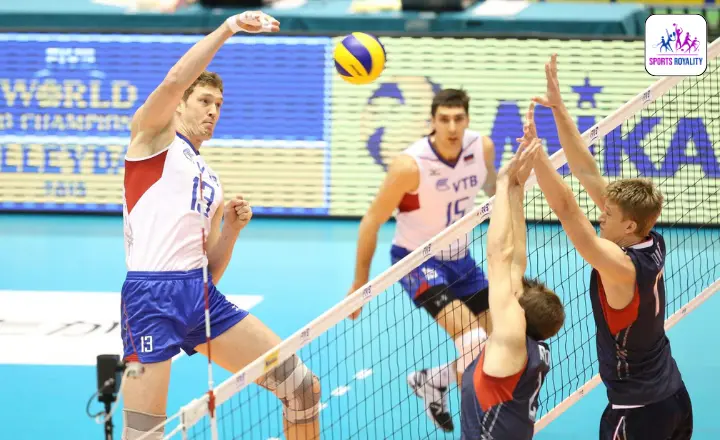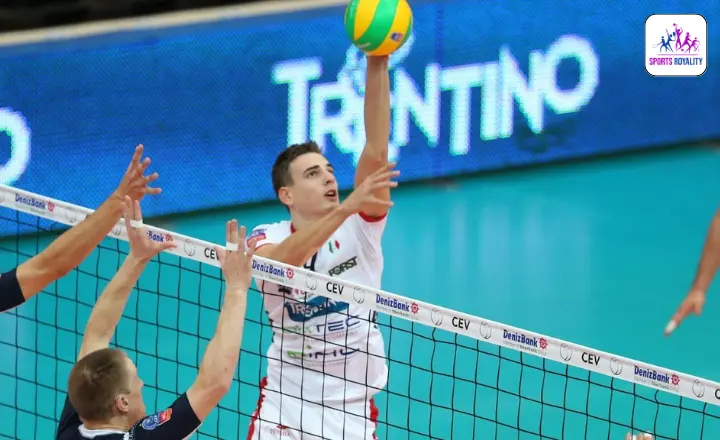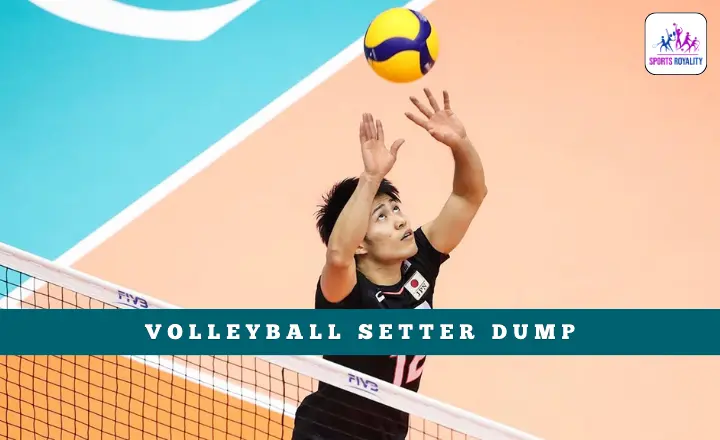Having a dump in your arsenal as a setter can be a precious asset. The Volleyball Setter Dumps desperately, trying to defend against an unexpected attack from an unlikely source. From the moment the setter receives the ball with delicate hands, seemingly preparing for a set or an assist to a teammate, they suddenly unleash a powerful and strategic dump over the net.
With lightning speed and impeccable timing, this maneuver catches everyone off guard, leaving opposing teams frustrated and unable to react swiftly enough. In this article, we delve into the world of volleyball setters and explore how this tactic can turn the tide of any match.
What Is A Volleyball Setter Dump?
In the fast-paced game of volleyball, setters play a crucial role in orchestrating the offense and setting up their teammates for successful attacks. One essential skill that every setter must possess is the ability to execute a dump.
A setter dump, also known as a quick set or an off-speed attack, occurs when the setter deceives the opponent by faking a set and instead lightly taps the ball over the net into an open space on the other side.

The purpose of a setter dump is multifaceted. It keeps the opposition guessing and disrupts their defensive positioning. When executed correctly, this sneaky move catches defenders off guard as they scramble to react to what they thought would be an attacking hit from one of your hitters.
It creates opportunities for easy points since most teams do not expect their opponents’ setter to contribute directly to scoring. Perhaps less recognized but equally important is that it boosts team morale and confidence when success is achieved with such cunning maneuvering.
Setters must have excellent control over their touch and the ability to alter ball trajectory as necessary.

What Are The Setter Dump Rules?
One fundamental rule in volleyball is that the setter must be positioned in the front court when making a dump set. This rule ensures fair play and equal opportunity for both teams.
The rationale behind this rule is to prevent an unfair advantage for the setter, who could execute a quick attack from the backcourt, catching the opposing team off-guard. Having the setter in the front court allows defenders to prepare themselves and adequately react to any potential offensive plays.
This rule not only balances out offense and defense but also adds an element of strategy and anticipation to the game. As opponents become aware of their opponent’s skilled setter, they can strategically position their blockers at the net, trying to predict where and when a dump might happen.
This forces setters to think twice before attempting a dump set, as it becomes riskier due to heightened defensive awareness.
Are Setter Dumps Illegal?
Setter dumps are considered legal when executed by the setter in the front court, provided that they make clean contact with the ball.
Can A Back Row Setter Dump?
Players in the backcourt, specifically back row setters, are prohibited from executing a setter dump as it is considered an attack on the ball.
Back Row Setters: Use The Setover Instead
Back-row setters are known for their ability to deceive the opposing team with their crafty moves and skillful plays. One such move is the setover, a quick and low ball set directly over the net into an open space.

Unlike the dump, which involves attacking the ball as if going for a spike only to place it over gently, the setover focuses on creating confusion by utilizing speed instead.
The beauty of using the setover lies in its unexpectedness and timing. As defenders scramble to adjust their positions in anticipation of a powerful spike from the front-row attackers, the back-row setter strategically chooses to execute this move.
With lightning-fast reflexes and precise control, they sail the ball just over the net before anyone can react. This remarkable play catches opponents off guard and maximizes efficiency in setting up an offense.
Not only does this maneuver work effectively against slower blockers on defense, but it can also be used as a variation when facing formidable blocks at higher levels of competition.
By deploying a variety of deceptive moves like these, back row setters become true masters of misdirection, leaving their opponents guessing and struggling to keep up with their clever strategies.
The setover is just one tool in their arsenal that enables them to manipulate defenses and create scoring opportunities for their team.
Is The Setter Dump An Option In The 6-2 Rotation?
Traditionally used in systems like the 5-1 or 4-2, where there is only one setter on the court at a time, many coaches have debated whether or not it can be effectively utilized in a 6-2 system.
One argument against using the setter dump in a 6-2 rotation is that it becomes easier for defenders to read and anticipate when a mess might happen with two setters on the court.
When both setters are front-row players and potential offensive threats, using them solely for dumps could limit their attacking options and potentially reduce overall offensive power.

There are some clear advantages to incorporating setter dumps in a 6-2 rotation. With two setters on the court, there is more excellent opportunity for deception and unpredictability.
By occasionally utilizing quick sets and back-set attacks from both setters instead of just dumping every time, defenders will have a more challenging time reading the play and adjusting their defensive positioning accordingly.
While using setter dumps may be less common in a 6-2 rotation compared to other systems like 5-1 or 4-2 formations where only one setter is present, it can still be an effective strategy if used strategically and sparingly.
Can Someone Besides The Setter Dump?
While the term setter dump suggests that only the setter should execute this move, there are instances where someone on the team can successfully pull it off. Allowing another player to dump the ball can catch the opposing team off guard and create confusion in their defensive specialist structure.
By breaking from traditional play patterns, a teammate who leaves unexpectedly injects an element of surprise into the game, potentially resulting in a quick point or advantageous positioning for their team.
Entrusting someone other than the setter with a dump highlights different offensive strategies within a team. It demonstrates trust and confidence in each player’s ability to read and exploit openings on the court.
Not only does this diversify scoring opportunities, but it also adds complexity to defensive schemes aimed at stopping predictable plays from the setter. By encouraging all players to be involved in executing such plays, teams become less predictable and harder to defend against.
Can A Spiker Do A Setter Dump?
When it comes to a spiker executing a setter dump, since most teams expect the ball to be set for an attack, they often position their defense accordingly.
When a spiker suddenly decides to execute a dump instead of going for a spike, this unexpected move can throw off even the most experienced defenders.

In addition to catching opponents off guard, utilizing a spiker dump adds versatility to the team’s offense. Allowing both setters and spikers to execute dumps throughout the game creates uncertainty for the opposing defense regarding who will make contact with each set.
This uncertainty forces them to adjust their blocking strategies constantly and opens up opportunities for misreads or defensive errors that skilled attackers can capitalize on.
How To Do A Setter Dump
The setter dump is relatively uncomplicated from a technical standpoint, but the real challenge lies in accurately determining the ideal timing for its execution.
Ensure You’re In The Front Court
To execute a setter dump, it is essential to be positioned in the front row and possess the ability to perform a jump set.
Make Sure The Pass Is Tight But Not Too Tight!
You’re aiming for a pass or dig that is moderately constrained but not quite an overpass. If it’s tightly positioned near the net, the opposing middle blocker will seek to block or joust the overpass, leading to interference with our setter’s dump.
Approach To Set, But Dump Instead
The approach to a dump is similar to setting, but instead of delivering a well-placed set to your teammates, you surprise everyone by softly tipping the ball over the net.
To successfully perform a setter dump, timing and deception are crucial. As you approach the net, ensure your movements mimic a typical set.
Jump as if you’re going to make contact with the ball at its highest point. At the last moment, quickly adjust your hands and wrists to guide the ball over gently.
This technique is especially compelling because it exploits defenders who may have shifted their focus on your teammates expecting an attack.
By choosing to dump instead of setting for a spell, you take advantage of open spaces in the opponent’s court for accessible scoring opportunities.
Executing well requires practice and finesse, but with time and determination, perfecting this technique could become one of your secret weapons on the volleyball court.
Maximize Deceptiveness
There are a few essential tips to keep in mind to maximize deceptiveness and make it more effective.
Timing is crucial: The setter should release the ball just as the blockers commit to their jump in anticipation of a set. This split-second decision can throw off their timing and make it harder for them to react.
Body positioning plays a significant role: The setter should mimic their usual setting motion and approach to disguise their intentions. By keeping an upright posture and using similar arm movements, they can lull the blockers into thinking it’s a regular set, only to deliver a sneaky dump over the net at the last second.
Communication between the setter and hitters: An effective volleyball setter dump requires a diversionary tactic where one or two hitters act like they’re going for an attack while intentionally leaving space open on either side of them for the ball to drop in.
This strategy adds another layer of confusion for defenders, who may be caught off guard by both the setter’s deceptive play and the unexpected positioning of hitters.
Can A Setter Dump With Two Hands?
Although a dump is usually more apparent to defenders, a setter can execute it using both hands.

Remember that this is not the same as a setover and would still be categorized as a dump dunk.
My former teammate, Arash Dosasnjh, has once again provided us with a textbook example of a setover (not a dump).

Can You Setter Dump In Beach Volleyball?
Setter dumps are a common tactic used in indoor volleyball, where the setter unexpectedly tips the ball over the net instead of setting it to their teammates. This strategy is a big no-no in beach volleyball. Unlike indoor volleyball, beach volleyball does not allow any open-handed tips or dinks over the net by the setter.
The main reason behind this rule is to maintain fairness and prevent any player from gaining an unfair advantage. In beach volleyball, players rely heavily on their defensive skills and ability to read their opponents’ play. Allowing setter dumps could disrupt this balance and give setters an unfair advantage over the blockers.
Haikyuu Setter Dumps
If you’ve been keeping up with the Haikyuu volleyball anime, you might have observed several instances where setters make surprise attacks. Now, let’s quickly look at some of the most remarkable plays and analyze them.
Kenma Setter Dump
The setter dump is a move that Kenma Kozume is well-known for employing on a regular basis.
Kenma is dumping the ball with his right hand, indicating that he is positioned incorrectly on the court.

The animators probably made an oversight, as it is uncommon for a setter to be positioned on the right side of the court.
Akaashi Setter Dump
Keiji Akaashi of Fukurōdani Academy is when he executes some incredible setter dumps. For those who may not be familiar with volleyball terminology, refer to a move where the setter quickly decides to attack the ball themselves instead of setting it for another player.

Akaashi’s setter dumps catch opponents off guard and display his intelligence and ability to read the game.
He has an innate understanding of when to execute this move, confusing his teammates and rival teams. This unpredictability makes him a formidable opponent on the court, as defenders often struggle to react in time or anticipate where he will send the ball next.
Oikawa Setter Dump
Oikawa often catches opponents off guard with his ability to read the court like a book. What truly sets him apart from other setters is his uncanny sense of finding poorly defended open spaces on the court to execute the dump.

With pinpoint accuracy, Oikawa exploits weak spots in his opponent’s blocking formation without mercy. He possesses a sixth sense when it comes to spotting these openings. His smooth movements and quick decision-making allow him to seize every opportunity, leaving opposing teams scrambling to react.
Conclusion
The volleyball setter dump is a highly effective and strategic move that can catch opponents off guard and lead to points for your team. By disguising your intentions and using proper technique, you can successfully execute this play and add another weapon to your arsenal.
Communicate with your teammates and practice the setter dump in different game situations to improve accuracy and timing. Dedication and practice can make you a skilled setter who sets up plays and contributes points directly through well-executed dumps.
FAQ’s
How can setters improve their ability to execute successful dumps?
Setters can improve their ability by practicing timing and deception techniques and developing good court awareness to identify optimal opportunities for dumps.
Can libero players execute a setter dump?
According to official volleyball rules, liberos in volleyball are prohibited from executing a set attack or performing any offensive action above the net’s height. Libero players cannot legally perform a setter dump.

